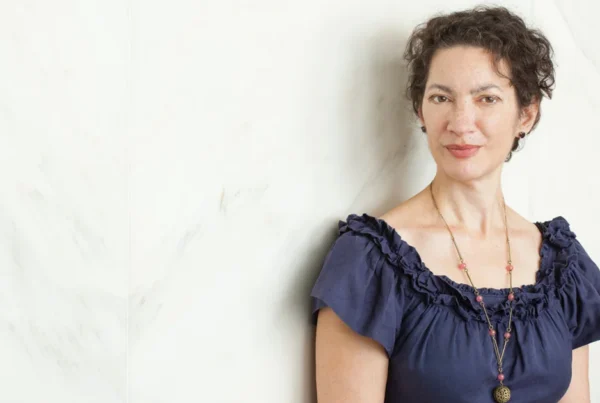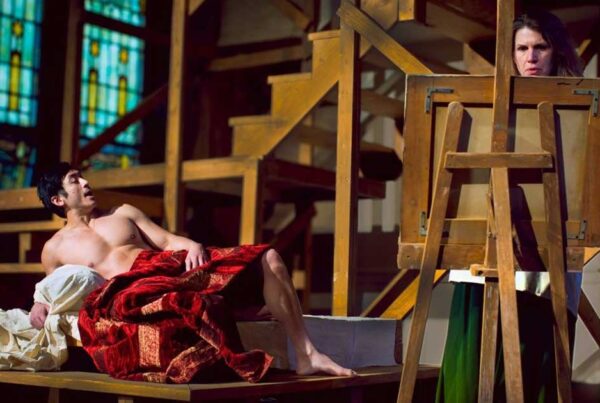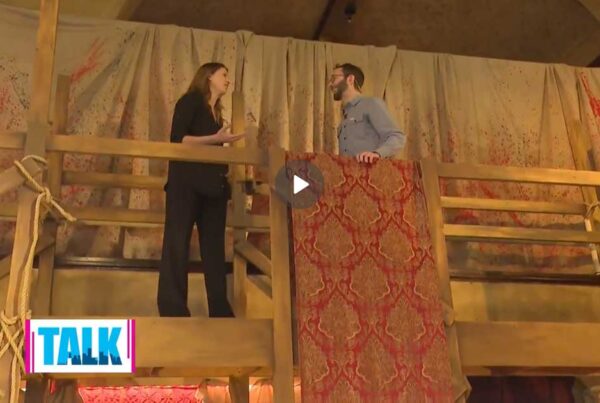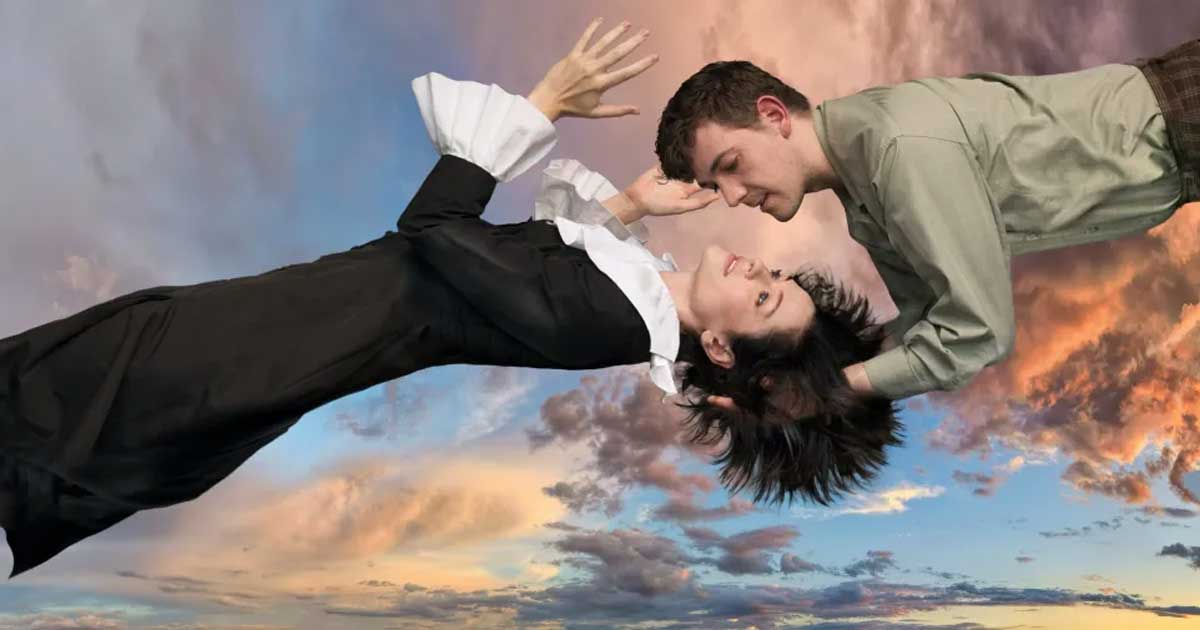
Zanny Laird and Dan Mayhak recreate the iconic image from “Over the Town.”
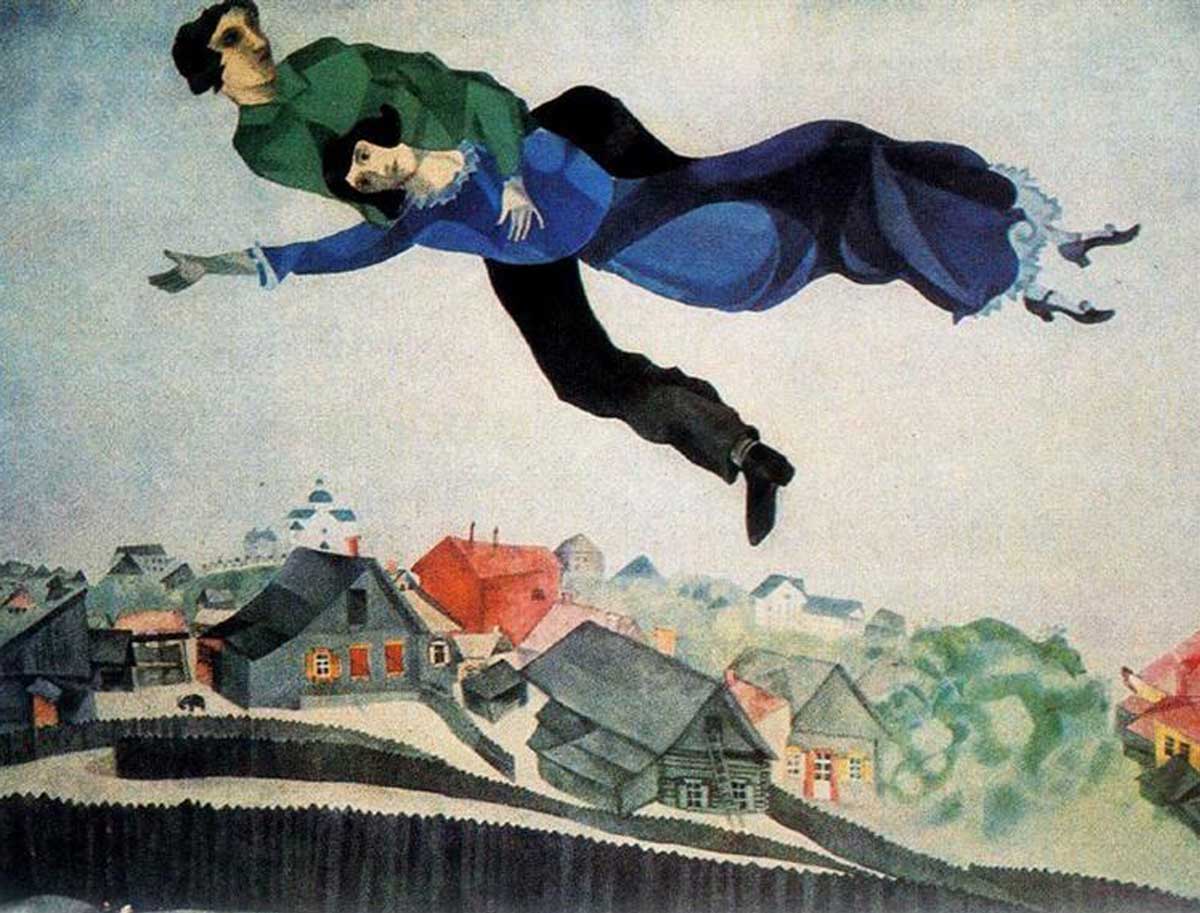
Over the Town the 1918 painting by Marc Chagall.
‘Burgh Vivant – When famous modernist artist Marc Chagall (Dan Mayhak) gets a call from a pretentious and elitist art snob (who speaks in metaphoric and bombastic gibberish), he looks back at his life with Bella Rosenfeld Chagall (Zanny Laird) in “The Flying Lovers of Vitebsk.”
Marc and Bella reflect on their lives in words and songs. Perspectives between husband and wife flips a bit back and forth, but the audience gets a glorious glimpse into each of their souls.
They meet in Vitebsk ( or Vitsyebsk or Viciebsk), a small village in Russia (now Belarus), but their journey together takes them westward, geographically, philosophically, idealistically.
Every time it looks like the world is ready to tear the Chagall’s to pieces, they rise up, fight or flee, surviving a multitude of perils. The tale is so lovingly told it’s hard not to fall in love with Marc and Bella despite their flaws.
“The Flying Lovers of Vitebsk” is subtitled “The Chagall musical,” but it’s more a play with songs than an actual musical. The distinction is a slight one, but notable. The songs are interspersed into the story, but, while beautifully rendered by Douglas Levine and company, they are not integral to the plot. It’s a good thing because most of them are in another language.
Mayhak sings in Yiddish (and occasionally in English). Laird sings in Yiddish and French. The only recognizable tune (at least for this gentle gentile) is “Bei Mir Bitsu Shein” made popular by the Andrews Sisters in the 40s (and no, I’m not THAT old).
Side note: When her now-husband, Lucas Fedele, proposed to Zanny Laird in Paris (take a moment to sigh and say, “How romantic!”), she didn’t speak a lick of French. You’d never know it. Edith Piaf would be proud.
Laird’s smile lights up the stage. Her character’s effervescent enthusiasm for life is infectious and Laird glows with charm. In the opening scenes, she bursts with joy when she details her first meeting with Chagall. Her love felt so powerfully real.
Mayhak does a remarkable job as the quixotic painter. He portrays Chagall in various stages of his life, idealistic young man, fervent artist, and despondent old codger. In Yehuda Pen’s portrait of Chagall, Mayhak even looks like artist as a young man (in reality, Chagall looked more like Harpo Marx without the curly blond locks).
The Yiddish singing from both the actors is tremendously impressive. You don’t have to know the words to be stunned by their renditions. Their faces express the meaning of the music.
Daniel Jamieson and Ian Ross use the written word in wonderful ways (in book and lyrics). Instead of blushing, Bella describes her friend’s face as red as a freshly washed radish. The phrase seems so perfectly appropriate to spill out of the mouth of a Jewish woman from a tiny Russian village.
There’s even a meta moment when Chagall, commissioned to paint scenic backdrops for a Jewish theater company in Moscow, laments about the actors and props moving too much on stage. Ironically, there does seem to be a little too much movement of the props under Gustavo Zajac’s direction, but his choreography of the actors is delicate and graceful. He does a fantastic job bringing this important story (at an important time) to life.
The band, Douglas Levine (keyboards), Cara Garofalo (violin) and Lenny Young (oboe, and English horn) play harmoniously, exquisitely. They also play a variety of background actors, mostly in non-speaking roles. Levine even manages to get a couple of the best laughs.
Grzegorz Labuda costumes look as if they are plucked from the Chagall closets. Bella is dressed in the frock identical to the one “Bella with White Collar,” a 1917 rendition of his wife looming large over Marc and Ida in a garden below.
Don’t let Stephanie Mayer-Staley’s stark white backgrounds fool you, they are the perfect canvas for Peter Brucker’s projection design.
Side note: This is Quantum Theatre’s 100th production and it rates high on a list of illustrious plays. This reviewer has not seen all one hundred, and it wouldn’t be fair to judge the artistic endeavors on a such a scale, but it’s another must-see show in a long line of must-see shows from Karla Boos and company.
“The Flying Lovers of Vitebsk” is a marvelous proclamation of pain, loss and love. It’s about loving and living life to the fullest, even when faced with the most dire of circumstances, an affirmation of freedom joyously told. Fly to the theater and see it.

